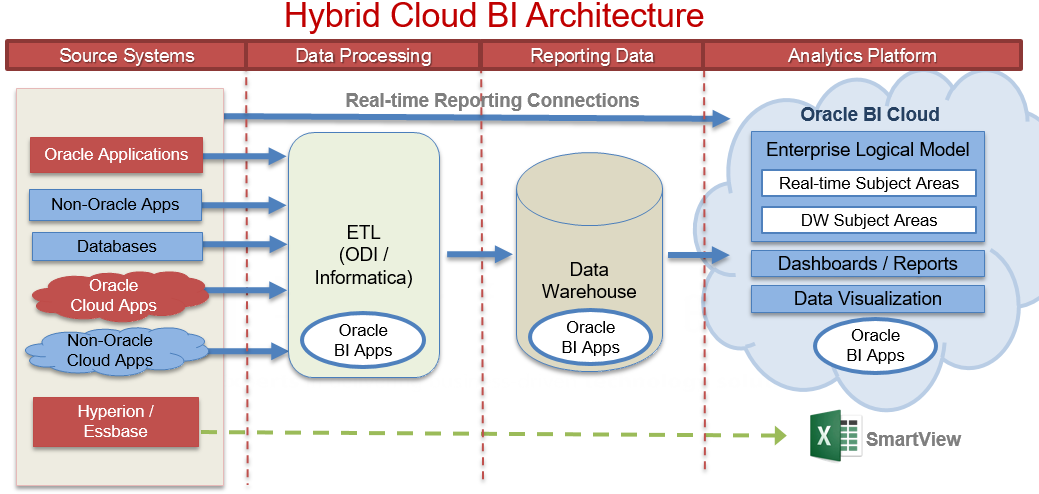I spend much of my time figuring out what things organizations are doing well when it comes to their enterprise analytics, what makes them better, and how to get there. After a few communications consulting for a new customer, I came to realize that they are likely categorized in one of three groups, most if not all of the time. This is based on how the BI team or business owners think of their situation:
- Group 1: We do our analytics on-premises and it’s been working just fine. No need to change what we’re doing.
- Group 2: We would love to move to Cloud, but it’s a big deal and we’re not ready to invest in rebuilding all that we have. Yeah, Cloud is nice and all, but we just don’t see how we can possibly get there.
- Group 3: Cloud is the direction for our organization. Let’s migrate.
Most of those in Group 3 are being proactive about it. That’s good, right? Well, not always. A company-wide Cloud strategy doesn’t necessarily mean that BI Cloud is the right step right away. Usually some form of a Cloud BI architecture is what ends up in my recommendation. However, there are those rare cases whereby staying on-premises, at least for the near future, made the most sense, given ongoing application upgrade plans and Cloud BI feature availability. While reducing cost is a driving factor towards the Cloud movement, it is business agility and scalability that tend to be as equally if not more important when strategizing for Cloud adoption. While Group 1 has not come to appreciate the benefits of a Cloud platform, Group 2 has, but is typically challenged by the ingrained culture, skills shortage, and the fact that there are several integrations with legacy infrastructure systems.
Gartner studies shows that by 2020, a “no cloud” policy will be as rare as a “no internet” policy is today. In addition, while in past years the interest in deploying cloud analytics platforms had been around 45%, mainly from the lines of business, more recent surveys show that cloud BI deployments increased to over 51% with a greater interest coming from IT professionals.
But how does one get there? With an OBIEE and a data warehouse that you’ve been hosting on premises for a while, and more interestingly, if you have Oracle BI Applications.
The key to the solution is to start with a tailored architecture that balances your business freedom with data governance. Chose the balance that is right for your organization. What this often means is to adopt a Hybrid Cloud approach as an interim solution. This hybrid model may apply to data and user base. By data I mean your databases remain on-premises until you are confident to move them into Cloud. And by user base, I mean some business users migrate to Cloud before others. OBIEE and Oracle BI Applications support the Lift & Shift method of Cloud migration, together with remote data connectivity from Cloud to On-Premises. With these two features, the velocity of Oracle BI Cloud adoption can be adjusted to what makes sense for your organization. And Lift & Shift insures that most of what you have running on-premises can be easily migrated as-is to Oracle Cloud – in either one of its forms: Business Intelligence Cloud Service (BICS) or Oracle Analytics Cloud (OAC). Gartner says “Oracle’s support for hybrid cloud deployments and data has given its on-premises BI customers a glide path to transition to the cloud. More than 54% of Oracle 12c’s on-premises reference customers are either deploying or planning to deploy Oracle BI in the cloud.”
In the following diagrams I aim to clarify the evolution process towards a full Cloud BI footprint. The first diagram depicts what is likely currently in place with all BI components hosted on-premises.

The diagram below shows a Hybrid Cloud Architecture as the BI platform layer moves to the Cloud while the data processing and storage layers remain on-premises. This is something that can be quickly done in a few weeks.

The third diagram now has a full BI Cloud footprint and includes the data warehouse and ETL layers. With Oracle Data Integrator (ODI) made available earlier this year as a Cloud service from Oracle, we can now migrate on-premises ODI repositories to ODI Cloud Service. And what is nice about it is that ODI mappings are decoupled from the underlying storage/database technology so ETL can seamlessly switch between different storage/database technologies (including non-Oracle) without rework. In the case of Oracle BI Applications, since ODI Cloud Service (ODICS) is not currently compatible, a BI Apps install is setup on Oracle Cloud Compute, therefore avoiding the need for on-premises servers for all BI needs.

Deciding on what BI components are better offloaded to Cloud and which parts are better kept on-premises is dependent on several factors that are specific to your current BI landscape. Among these factors are the BI applications that are currently in use and where the data is sourced from. An assessment of the current systems, prevailing challenges and future plans for extensibility and scalability provides a roadmap of how soon migrating BI to Cloud starts being effective and how many phases are optimal for such migration.
